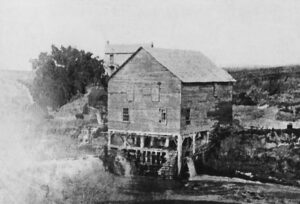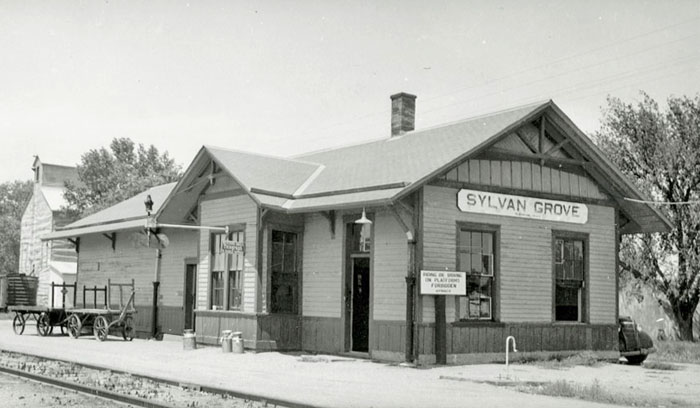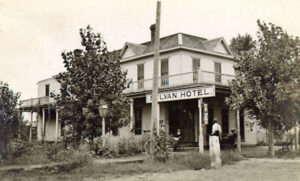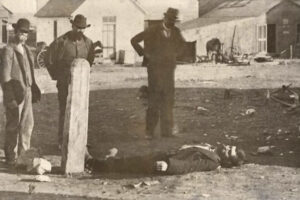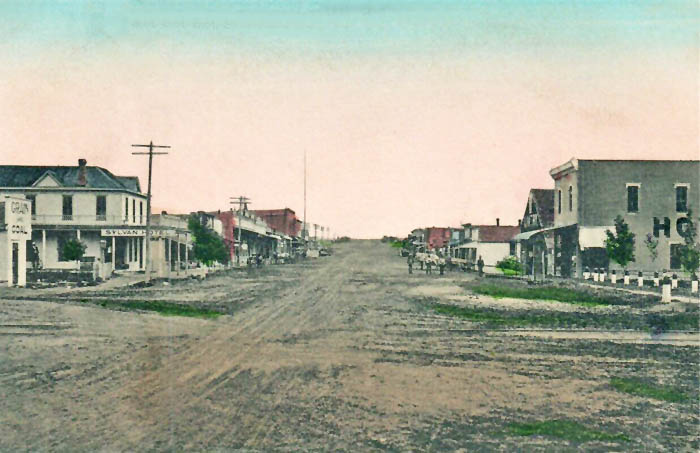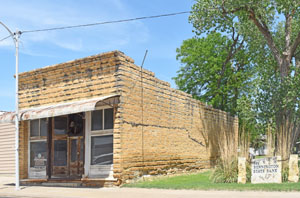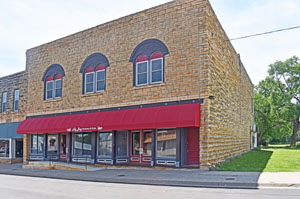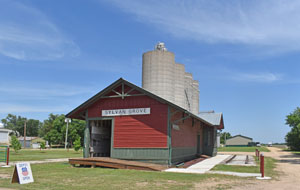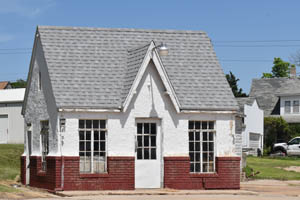Sylvan Grove, in Lincoln County, is located in north-central Kansas, designated as “Post Rock Country.” As of the 2020 census, the city’s population was 291.
Louis Farley and his son Hutchison were the first settlers to come into this neighborhood near the Saline River in about 1867. The Farley homestead was called Twin Groves. The Buzicks, who came in 1870, were the next family to move in. They became prominent in the county, with Ira Buzick becoming the first representative to be elected from Lincoln County, W. C. Buzick becoming the county clerk and editor of a Lincoln newspaper, and A.R. Buzick, one of the wealthiest men in the county. C.M. Heaton and the Meyers boys came in 1871.
Though the town wouldn’t be founded for several years, there was enough area population for a post office called Sylvan Grove to be established on December 12, 1872. It was located two miles south of where the town would be established, in the home of C. M. Heaton, the postmaster. It was named after twin Sylvan groves that were nearby.
In 1877, the post office moved to the home of H.S. Merriman. That year, a flour mill was constructed by H.S. Merriman and A.J. Masterson. Containing three runs of stones, it operated both day and night, soon earning a reputation as one of the better flouring mills of the West. Farmers from 30 miles away were known to have lined up the night before to have their wheat ground into flour. The town was platted the same year on land belonging to William Bender and H.S. Merriam. E.B. Cross and W. F. Morgan erected the first store called the Cross & Morgan General Store. It was later sold to Berger Brothers & Wilson. Later, Schermerhorn & Company bought interest. This was the only store before the coming of the railroad, and people came from miles away to do their shopping.
A disastrous flood in 1886 destroyed the mill, and the townspeople responded by relocating northeast to higher ground to avoid future flooding and to be near the new railroad line that was expected soon. The site was about one-half mile northeast of its original location.
The new town was platted in 1887 by the Sylvan Grove Town Company on land that belonged to William Bender and H. S. Merriman.
“Although the town is only a few months old, the strides she has made in that brief period is amazing. Its location in the western part of Lincoln County, 16 miles from the county seat and at least 20 miles from any other town of importance, gave it advantages as a business point which are unexcelled by any other new town in Western Kansas.”
— Sylvan Grove Sentinel, July 28, 1887.
The Salina, Lincoln & Western Railway, a branch of the Union Pacific Railroad, arrived in September 1887, giving Sylvan Grove a second chance for growth. Work on the depot began within a few weeks of completing the track. The building was erected quickly, with all but the painting completed by the end of September. The first freight delivery—an order for J.W. Gates and the Spot Cash Grocery—arrived a few days later.
The railroad brought mail, lumber, supplies, people, and almost anything needed to build and sustain a settlement. As Sylvan Grove grew and farms were established, the railroad provided the means to efficiently market grain, cattle, milk, poultry, eggs, and other agricultural items.
Work on a water well adjacent to the tracks began in mid-October and was finished late in the year when a tank was brought in from Lincoln.
Businesses quickly sprang up at the new location to meet the needs of people coming to the area, and the business district began to take shape when at least 25 business buildings had been erected, and more were in the works. These included a hotel, two lumber yards, two restaurants, a boarding house, a bakery, a billiard hall, a hardware store, a drug store, a grocery store, a meat market, a blacksmith shop, an agricultural implement house, and two barbershops. The first commercial buildings constructed in Sylvan Grove were primarily wood-frame structures.
The town experienced much growth in the late 1880s. The railroad brought with it boundless opportunities for immigrants and businessmen. Many settlers entered the area to secure prime farmland through the Homestead Act of 1862.
During the 1890s, the growth of the little town began to stabilize. In 1892, three churches — Lutheran, Presbyterian, and Methodist were built, and public and parochial schools provided education for the town’s youth.
On the afternoon of November 12, 1894, three well-armed men rode into Sylvan Grove. One rode up to a stone-hitching post in the rear of the Sylvan State Bank, hitched his horse, then leisurely walked into the bank. In the meantime, his two companions halted in the middle of the street in front of the bank to distract any passerby.
The desperado who entered the bank walked up to the cashier’s window and requested change for a silver dollar. Nineteen-year-old William D. Schermerhorn, who was working at the window, was the only employee in the bank. Schermerhorn complied with his request and counted out ten silver dimes, and some small talk was exchanged. This was only a ruse to see how matters were progressing in the street. The outlaw, then, while standing by the front window, with his back to the cashier, threw open his coat and drew a revolver, and wheeling suddenly presented it at the cashier’s head with the exclamation, “Don’t holler or g__ d___ you, I’ll blow your brains out.”
He then produced a canvas bag, held it to the cashier, and ordered him to open it and shove the money in. However, Schermerhorn refused to comply, and after a bit of parlaying, the fellow suddenly struck him on the forehead with the revolver. Although not seriously hurt, Schermerhorn dropped to the floor with his body covering a Sharp’s rifle, which lay on the floor. The robber then hurriedly helped himself to $1,734, left the bank, and walked towards his horse.
In the meantime, quick-witted, courageous young Schermerhorn had picked up the Sharp’s rife, run out of the front door, stepped around the corner of the building, and took aim at the desperado just as he flung the sack on the saddle of the horse, and fired the only load in the rifle. The ball hit the man just to the back of the right arm and came out at the left side of the breast, passing through the heart and killing him instantly.
The two other outlaws began firing at Schermerhorn and frantically tried to get possession of the money sack but were thwarted when William Brumbaugh, one of the proprietors of Brumbaugh & Bowen’s livery stable, grabbed a revolver and joined in the gunfight. The remaining two outlaws managed to escape, but it was later learned that the dead man was Anthony McKee, brother-in-law to the notorious outlaw Henry Starr, who was in the Fort Smith, Arkansas jail at the time. Basing their operations out of Mitchell County, the outlaws were on a crime spree throughout the region when McKee was killed.
Just as Sylvan Grove was establishing its business district, a fire in 1897 on West Main Street destroyed many wood frame businesses, including Seirer’s blacksmith shop, a barbershop, Raffety & Nesmith’s Store, Gallagher’s Harness Shop, Knapp & Company’s Store, and the Sylvan State Bank, all on the west side of Main Street.
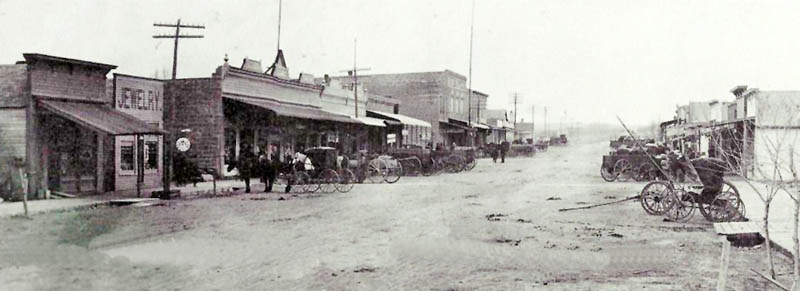
Sylvan Grove, Kansas Main Street.
Afterward, the first permanent masonry buildings began to be built. The Sylvan State Bank was rebuilt with limestone, as did Knapp Hardware and the Yellow Front. During this time, trees and forests were not abundant; however, substantial limestone deposits, known as the Greenhorn Limestone Formation, were readily available near the ground’s surface. The resourceful settlers quarried the stone to construct many permanent commercial and residential buildings, barns, outbuildings, and fence posts. Many European immigrants were knowledgeable and experienced in masonry, leading the way in constructing early stone buildings.
Sylvan Grove was incorporated on October 12, 1899. Telephone service became available in 1901. That year, Cuddy & Hardesty’s Drug Store was built with limestone, and in 1905, Reinhold Wohler built a two-story store next to his drug store for Behrhorst Brothers.
In 1910, Sylvan Grove was an incorporated city of the third class. Located on the Union Pacific Railroad, at that time, it boasted a bank, two grain elevators, a weekly newspaper called “The News,” a hotel, several retail establishments, telegraph and express offices, an international money order office with two rural routes, and the professions are well represented. Its population was 464.
In 1911, electric lights and a water tower were established, making Sylvan Grove a community with many modern conveniences.
In 1925, a fire on East Main Street destroyed Hugo Buehring’s Barber Shop, S.M. Lawson Co., Hardware, Abe Seirer’s Ford Garage, Rubin Alley Jewelry Store, Jim Alley Pool Hall, the livery stable owned by Jim Alley, and the hotel owned by Grattige. Again, the enterprising merchants rebuilt.
The Great Depression and Dust Bowl years took a toll on Main Street businesses. The Farmers State Bank, which had been in operation since 1909, folded in 1931, and many farmers who could not make a living had moved away. Sylvan Grove’s population peaked in 1940 at 540 people and would gradually drop in the following decades.
Until the mid-1950s, local citizens came to the depot to board the jitney, a railroad passenger car that took them to Salina for shopping and business.
New construction on Sylvan’s Main Street was limited in the next several decades. However, many businesses were able to stay in business for decades. These included S.M. Lawson Hardware (75 years); the Wunderlich, Cross, and Farmer’s Elevator (106 years); the grocery store known as Berger Brothers, Calene Mercantile, Krysl IGA, Thaemert IGA, and Mitchell’s Grocery (109 years); and the Sylvan State Bank established in 1887, now Bennington State Bank, which is still in operation today.
Just as Sylvan Grove grew with the coming of the railroad, transportation played a big part in its downfall. The construction of the new Kansas State Highway 18 north of town in 1958 bypassed Sylvan Grove by a mile.
School unification consolidated Sylvan Grove schools with Hunter and Vesper schools to form Sylvan Unified Schools in 1966.
The closing of the Sylvan Grove depot in 1968 marked the beginning of a gradual decline in Lincoln County and throughout rural Kansas.
In 1969, a fire destroyed the newly remodeled Home Cafe and Ray Blase’s garage on East Main Street.
By 1970, with its four-lane design, the new Interstate Highway 70 made travel through Kansas even more convenient and fast.
During these years, businesses found it hard to compete with larger towns in the area, and many that had been the face of SylvanGrove’ss Main Street soon went out of business. These included Stuive Furniture, Andy’ss Grocery, Gatewood Chevrolet, Geyer Implement, and Kaempfe Produce. The east side grain elevators burned down in 1977.
Following a flood in 1993, the rails on either side of the depot were removed. The Sylvan Grove Union Pacific Depot was moved from its original location to 131 S Main Street.
In 2010, school unification combined Sylvan Unified with Lucas-Luray schools to form USD 299, Sylvan-Lucas Unified schools. Sylvan-Lucas Unified is located in Sylvan Grove.
Sylvan Grove’s depot was listed on the National Register of Historic Places on April 2, 2014. Built in 1887, the line was initially known as the Salina, Lincoln & Western Railway, which later became a part of the Union Pacific Railroad. The Depot features a passenger waiting room, agent’s office, and freight room containing historical artifacts and memorabilia. It is the oldest structure from that era. The local Historical Society owns it.
On August 1, 2020, Sylvan Grove’s downtown commercial district was officially listed in the Register of Historic Kansas Places. Of the 36 properties within the district, 20 were built between 1887 and 1930. A prominent characteristic of the district is the multitude of buildings built out of the native Greenhorn limestone, locally referred to as “Post Rock” limestone. Architectural details can be seen in metal facades, cornices, cast-iron columns, and window hoods.
Today, Sylvan Grove is home to the Lincoln County Fairgrounds, where the county fair is held each summer. Livestock exhibits, a demolition derby, food, and live entertainment are just a few of the fair’s attractions. The town also offers a beautiful city park, a library, and a museum. Sylvan Grove is a full-service community in a small-town atmosphere.
On the first Sunday of June, Sylvan Grove hosts Community Day, which features old-fashioned fun like turtle races, pickle-eating contests, live entertainment, and free hot dogs and watermelon. Families and neighbors come together for a day of relaxing and visiting.
The town is only 12 miles from Wilson Lake, boasting some of Kansas’s top boating, swimming, fishing, and camping.
Sylvan Grove is located 12 miles west of Lincoln, the county seat. It is located along Kansas Highway 181, the town’s Main Street.
©Kathy Alexander/Legends of Kansas, updated June 2024.
Also See:
Sources:
Barr, Elizabeth N., A Souvenir History Of Lincoln County, Kansas, 1908
Historic Register Nomination – Depot
Historic Register Nomination – Business District
Lincoln Sentinel, November 15, 1894
Live Lincoln County
Travel Kansas
Wikipedia


